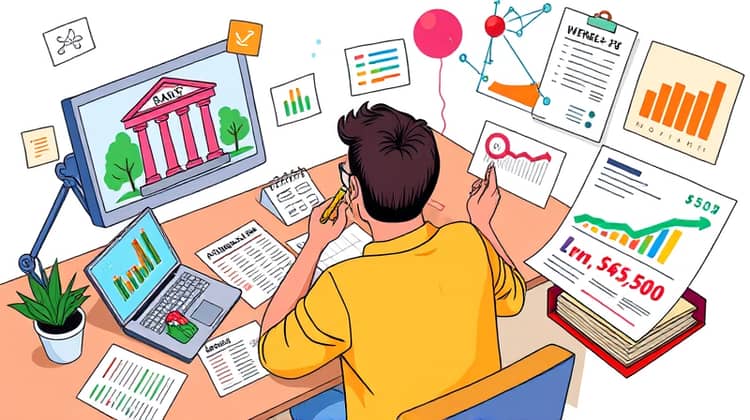Navigating the personal loan process can seem daunting at first, but understanding the steps involved can simplify it significantly. This article will walk you through the various stages, from determining your financial needs to the final repayment of your loan. By the end of this guide, you should feel more confident in your ability to secure the right loan for your personal situation.
1. Determining Your Needs

Before you even start looking for a personal loan, it's crucial to identify your specific financial needs. What do you plan to use the loan for? This could be anything from consolidating debt, financing a large purchase, covering medical expenses, or even funding a special event. Understanding your purpose will help guide the amount you need to borrow and the type of loan that is most suitable for you.
Additionally, consider how much you can afford to repay each month. Analyze your current financial situation, including your income, expenses, and other debts. Setting a solid budget will ensure you choose a loan that aligns with your financial capability. Watch out for charges that can add up, such as origination fees, and always factor these into your overall budget.
- Identify the purpose of the loan.
- Evaluate your monthly budget and repayment capabilities.
- Consider any associated costs or fees.
- Determine your loan timeline.
After you have defined your needs, you can move on to the next step of researching the various loan options available to you.
2. Researching Loan Options

The next step is to explore different loan options. Researching your choices will allow you to find a personal loan that best suits your financial situation. Make sure to look into both traditional and alternative lenders, as they can offer different terms and rates. Evaluating multiple lenders will give you insight into what you can expect for interest rates, loan amounts, and repayment periods.
- Visit websites of banks and credit unions to compare rates.
- Check online lending platforms for flexibility and terms.
- Consider peer-to-peer lending for alternative options.
- Look into loan programs specific to your needs.
Once you have a comprehensive understanding of the available loan options, it’s time to check your credit score, as this can greatly influence your loan approval and the terms you receive.
3. Checking Your Credit Score

Your credit score is a key component to obtaining a personal loan, as it reflects your creditworthiness. Lenders use this score to assess the risk of lending money to you. Generally, a higher credit score will not only improve your chances of approval but can also lead to lower interest rates.
You can obtain your credit report from several agencies for free once a year. Review it for any inaccuracies and ensure that all your financial behaviors are reported correctly. If you identify any issues, address them promptly, as they could impact your ability to secure a loan.
4. Gathering Documentation

Once you’ve determined your needs, researched your options, and checked your credit score, the next step is gathering all necessary documentation for the loan application. Lenders usually require a range of documents to verify your identity, income, and financial history. Being organized and prepared with your paperwork can expedite the loan approval process significantly.
Common documents you may need include tax returns, pay stubs, bank statements, identification documents, and proof of any additional income you may have. The specific requirements can vary by lender, so check their documentation checklist.
- Proof of identity (e.g., driver’s license or passport).
- Recent pay stubs or salary statements.
- Tax returns from the previous two years.
- Bank statements for the last few months.
5. Applying for a Loan

Now that you have all your documentation in order, you’re ready to apply for your chosen personal loan. This typically involves filling out an online application or visiting a lender in person. Make sure to complete the application accurately and ethically. Provide all requested documentation, and don’t hesitate to ask questions if you need clarification on any part of the application process.
Keep in mind that every loan application can lead to a credit inquiry, which may have a slight impact on your credit score. Therefore, consider the timing of your applications, perhaps consolidating your applications into a short time frame will minimize the effects on your score.
- Fill out the application form carefully.
- Submit necessary documentation.
- Review the terms outlined in the application process.
6. Awaiting Loan Approval

After submitting your application, you will enter the awaiting period for loan approval. This timeframe can vary based on the lender and the type of loan you applied for. Some lenders can give decisions instantly based on their online platforms, while others might take several days to weeks for manual reviews.
During this period, it’s a good time to review your financial plan and ensure you are prepared for the next step, whether that’s securing a different type of loan or getting ready to manage repayment if approved.
7. Reviewing Loan Terms

Upon receiving approval for your loan, the lender will provide you with the loan agreement, which outlines the terms of your loan. It is crucial to read this document thoroughly to understand your obligations. Take your time to review not just the interest rate but also the total amount to be repaid, any fees that may apply, and the repayment schedule.
If you have any questions or need clarification on aspects of the loan terms, do not hesitate to reach out to your lender. It’s better to have a clear understanding before signing any agreements.
- Loan amount and interest rate.
- Repayment schedule and duration.
- Fees and penalties for late payments.
- Conditions for early repayment.
8. Accepting the Loan

Once you’re confident in the terms presented, it’s time to accept the loan. This usually involves signing the loan agreement and submitting any final required information. Make sure to keep a copy of the agreement for your records, as you'll want to refer back to it throughout your repayment process.
Ensure that you also understand how the funds will be disbursed. Some lenders will deposit the loan amount directly into your bank account, while others may require you to specify how you will receive the funds.
- Sign the loan agreement.
- Confirm how the funds will be disbursed.
- Keep a copy of all documents.
Accepting the loan is just the beginning, as you’ll soon move on to utilizing the funds effectively for their intended purpose.
9. Using the Loan Funds

Once you receive your loan funds, it’s essential to use them wisely. Depending on the purpose of the loan, create a plan to ensure that the money serves its intended goal. For instance, if you’re using the loan for a home improvement project, drafting a budget can help avoid overspending and keep the project on track.
Always remember to keep track of your expenses and stay within your budget to avoid falling into further debt or financial strain.
10. Repaying the Loan

Repayment of your loan is a crucial step towards financial stability. Be sure to adhere to the repayment schedule established in your loan agreement, as missed or late payments can negatively impact your credit score and lead to additional fees. Set reminders for payment dates to ensure you never miss a deadline.
If possible, consider making extra payments towards the principal amount to reduce overall interest paid over time. This can save you a significant amount of money in the long run.
11. Impact on Your Credit

Timely repayment of your personal loan can have a positive impact on your credit score. Consistent payments demonstrate your reliability to lenders, which can be beneficial if you want to apply for more credit in the future. On the other hand, late payments or defaults can adversely affect your credit and make it more challenging to secure loans later on.
Managing your loan responsibly is an integral part of your financial health, and monitoring your credit score regularly can help you stay informed about any changes that could affect your financial decisions.
Conclusion

Understanding the personal loan process is essential for successfully navigating your financial needs. By determining your needs, researching options, checking your credit score, gathering necessary documentation, applying prudently, and managing your loan responsibly, you can enhance your financial wellbeing. Remember that your credit health is an ongoing process that directly relates to how efficiently you handle personal loans and other financial products.














